The ancient women left their stunning figures in the ancient poets, and their bejeweled were equally eye-catching.
That brilliant hanfu jewelry like a river of stars, will set them off quiet, elegant, highlighting the unique charm.
In this article, let's go into the history of gorgeous Chinese traditional necklace and choker and see how the ancient people carried forward the beauty of neckwear.
The Ancient Times
When our ancestors were still living in cold, dark caves, the sense of beauty was already awakened. They searched for anything that resembled "beads", drilled holes in them, strung them on chains, and wore them around their necks. Some of them were also painted red with hematite powder.
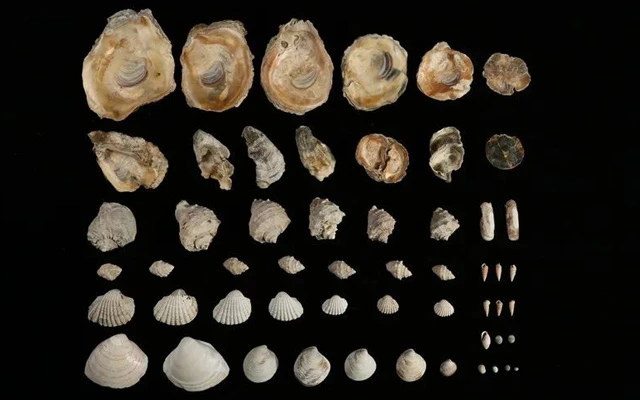
Seabed mollusk shells excavated from the Jingtoushan site in Yuyao, Ningbo, Zhejiang
At the Zhoukoudian Peking Man site, which is about 30,000 years old, a large number of neck ornaments have been unearthed. These neck ornaments are made of different materials, including gravel, animal teeth, fish spine bones, and bird bones, all of which have been carefully selected and polished.
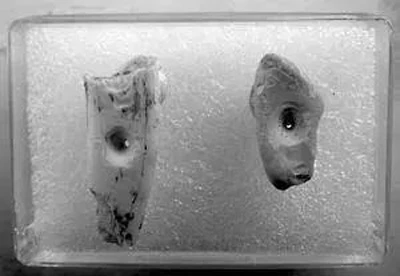
Drilled animal tooth ornaments excavated from the Zhoukoudian Peking Man site
Among them, there is a string of rabbit bone chains, consisting of 12 pieces of rabbit backbone, each of which has a hole for threading. The holes have been worn out and deformed due to long-term wear, which is a testimony to the beauty of the Paleolithic cavemen.
In the Neolithic period, neckpieces were more colorful, and there were necklaces made of seashell, conch, bone, tooth, stone, jade, and so on.
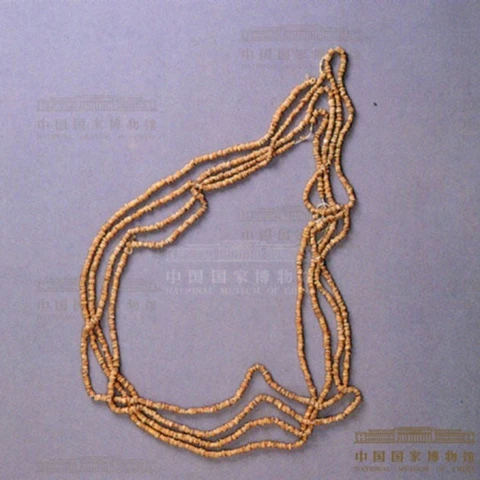
Bone bead necklace - Collection of the National Museum of China
In 1966, the remains of a sixteen-year-old girl were excavated from an early Neolithic tomb discovered in Beijing's Mentougou Donghulin Village, about 10,000 years ago.
She was wearing a necklace made of small conch shells around her neck. In that era of extreme material poverty, these 50 or so conchs of various sizes accompanied a young girl in her flowering season for 10,000 long years underground.
Shang Dynasty
With the advancement of jewelry making and the influence of the nobility's luxury, the development of traditional Chinese necklace ornaments entered a whole new era during the Shang Dynasty.
The neck ornaments excavated from the tomb of Fu Hao in Yinxu were made of a large number of precious materials: tubular jade beads, round jade beads, stone beads, agate beads, turquoise beads, and so on. These beads, large and small, are strung together to form a necklace of unparalleled beauty.
The Shang Dynasty was the peak of the use of jade, many traditional necklaces made of jade. In addition to this, the Shang dynasty also had neck ornaments made of plum-shaped, disc-shaped amber and red agate beads, as well as "mussel ornaments". Ancient people used shellfish to make necklaces and wrapped them around their necks or waists as decoration.
Qin and Han dynasties
By the Qin and Han dynasties, there was a proliferation of beautifully crafted gold neckpieces. A breathtaking gold bead necklace was unearthed from the Eastern Han tomb at Wulipai in Changsha, Hunan Province.
It was strung with hundreds of gold beads in three different shapes, the first being a gold bead made of tiny gold grains glued together in three circles, the second made of small gold tubes linked together, and the third being an eight-square bead, strung together and glittering. In addition, the necklace has a flower spike-shaped gold pendant, more delicate and dexterous.
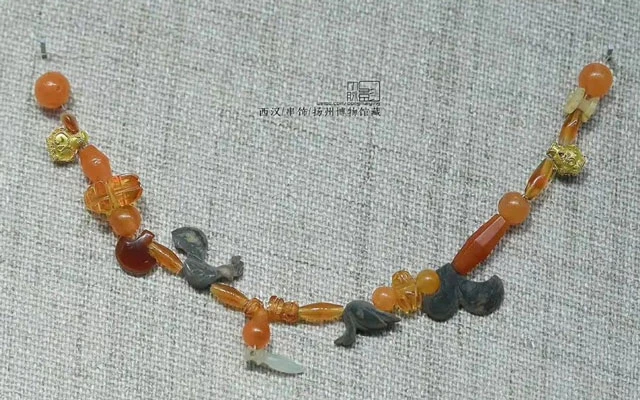
Necklace of Western Han Dynasty - Yangzhou Museum Collection
At that time, in order to paint exquisite patterns on the necklace, people used a pulp made of fresh plant leaves pounded with soda, painted on the surface of polished beadwork, and then heated to present specific patterns.
With the "gold", but also "pattern". At that time, in order to paint exquisite patterns on the necklace, people used a pulp made of young plant leaves pounded with crystal soda, painted on the surface of polished beadwork, and then heated to present specific patterns.
Sui and Tang dynasties
During the Wei, Jin and Northern and Southern Dynasties, necklaces with animal flower and bird-type motifs began to appear. The neck ornament components excavated from the tomb of the Eastern Jin Dynasty in Nanjing Xianheguan include gold sheep, gold pair of lovebirds, gold turtles, and so on.
To the Tang Dynasty, these animal styles gradually disappeared again, and began to be popular with gold pendants inlaid with precious stones, pendants with gold clasps.
In 1957, the tomb of Li Jingxun near Liangjiazhuang in Xi'an, Shaanxi Province, was discovered, and a gold necklace inlaid with pearls, bloodstone was introduced.
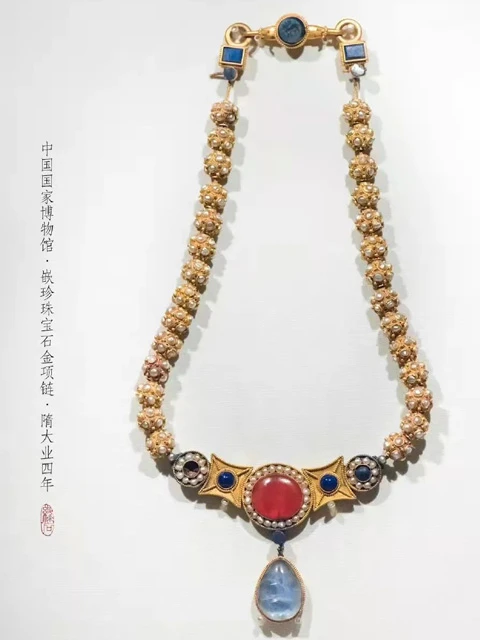
Sui Dynasty - Gold necklace with inlaid pearls and precious stones - Collection of the National Museum of China
The owner of the tomb, Li Jingxun, was the granddaughter of Princess Yang Lihua of the Sui Dynasty, and was only nine years old when she passed away. She was lying in a beautifully carved stone coffin, surrounded by treasures. Among them, the gold necklace around her neck is particularly brilliant and eye-catching.
The gold necklace is about 43 cm in circumference, and the chain is composed of 28 gold spherical beads embedded with pearls and strung with a multi-stranded gold wire braided chain. Each bead is made of 12 small gold rings welded together, and each ring has a circle of small welded beads and five large welded beads, on which 10 pearls are embedded.
The upper end of the necklace is a clasp with a central inlay of intaglio lazurite, with a gold hook on each side connecting the chain. The lower end is a large round gold ornament, surrounded by 24 pearls, with a piece of bloodstone in the center, the bright red bloodstone with white pearls, under the background of pure gold, the interplay, elegant. And the bottom hanging heart-shaped gold jewelry set on a piece of 3.1 cm long treasure blue lazurite, is extremely rare.
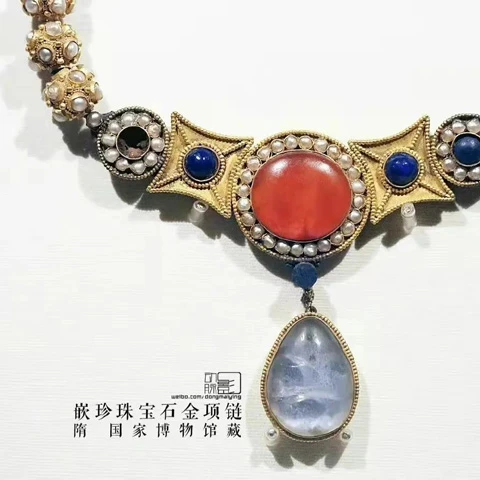
Sui Dynasty - Gold necklace with inlaid pearls and precious stones - Collection of the National Museum of China
When the princess, who was loved by everyone, died in her prime, the grief-stricken elders put on the most colorful gold necklace for her, and even after being buried in the ground for more than a thousand years, it is still as bright as new, just like the unchanging attachment of kinship.
The gold necklace of Li Jingxun's tomb is intricately crafted, and its design is a mixture of various elements, with intaglio carving techniques dating back to ancient Mesopotamia and the Iranian plateau. It can be seen that there were frequent cultural exchanges between ancient China and the West during the Tang Dynasty, and the jewelry craft was prosperous as never before.
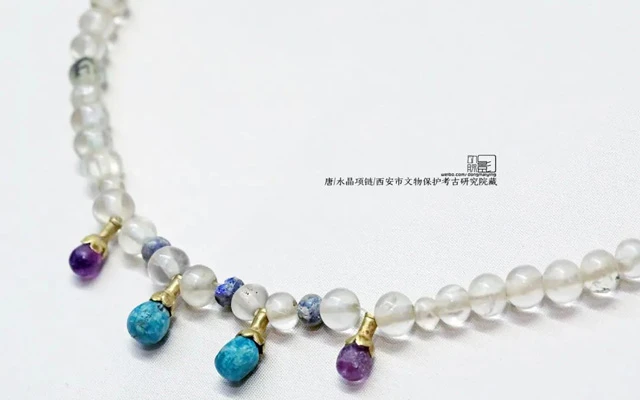
Tang Dynasty Crystal Necklace - Xi'an Institute of Cultural Relics Protection and Archaeology Collection
In the Tang Dynasty, another special traditional necklace also became popular among women's necks, and that is "Ying Luo (璎珞)".
The word "Ying Luo" originated from Sanskrit "Keyūra" and originally referred to the neck ornaments worn by Indian nobles. During the Tang Dynasty, it was introduced Buddhism. The Chinese word "Ying Luo" mainly refers to the string ornaments worn around the neck, mostly made of pearls, precious stones, and gold, silver, and precious metals in series.
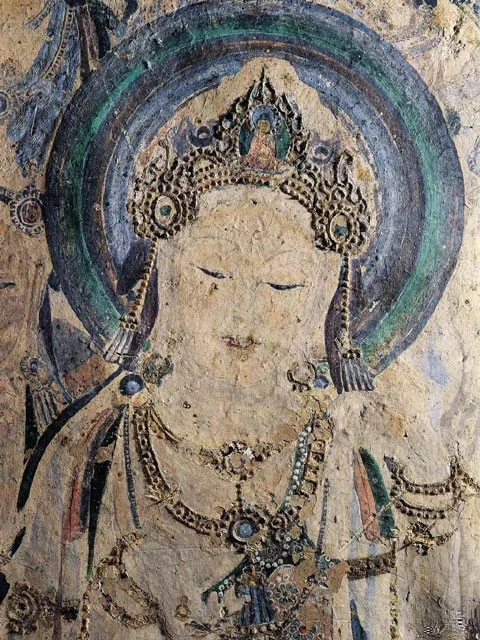
Mogao Caves Murals
Song Dynasty
During the Song dynasty, the craft of piercing and chain linking was already very exquisite in the production of the traditional necklace.
A pendant was excavated from a tomb of the Northern Song Dynasty in Makufu Mountain, Nanjing, with a pendant carved with an elaborate design, surrounded by a scrolling grass border, and a piercing in the center of the top Ruyi head designed to connect to a chain.
In 1987, a Chinese shipwreck from the Southern Song Dynasty was accidentally discovered, and a 1.72-meter-long gold necklace made of four strands of eight pure gold threads with a herringbone pattern and a twist-like shape was recovered.
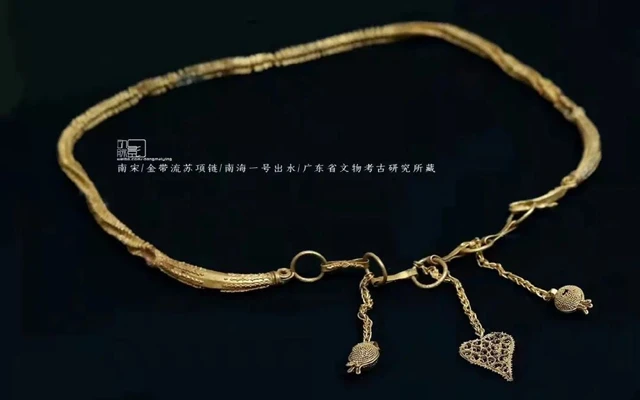
Southern Song Dynasty Gold Banded Tassel Necklace - Collection of the Institute of Cultural Relics and Archaeology of Guangdong, China
It has a long grape pattern with hook as the head, four rings buckle into the tail, a peach heart gold pendant in the middle, the fine design, the same can see the maturity and progress of the Song Dynasty jewelry technology.
During the Southern Song Dynasty, overseas trade was developed, and this necklace was carried on board with a large number of other precious goods to be transported on the Maritime Silk Road.
Ming and Qing Dynasties
During the Ming and Qing dynasties, a special neck ornament, the "Chang Ming Suo (长命锁, Longeval Lock)" became popular. It is an ornament hung around the neck of a child, and can be traced back to the Han Dynasty.
In the Han Dynasty, every Dragon Boat Festival, families are hanging the five-colored silk rope on the lintel to avoid bad luck. This five-color silk rope named "Chang Ming Lü", after a long period of evolution, became a symbol of good luck "Chang Ming Suo".
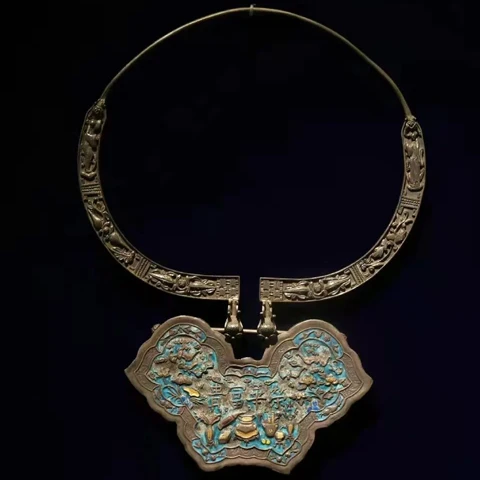
Qing Dynasty Chang Ming Suo
Longeval Lock come in a variety of shapes: round, rectangular, diamond-shaped, and so on.
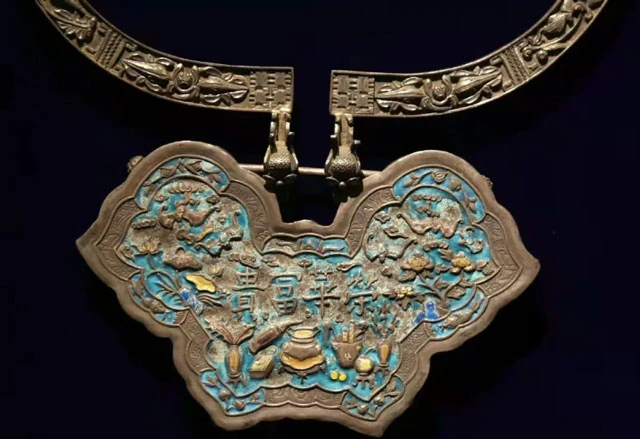
Qing Dynasty Chang Ming Suo
Compared to the simple decoration, the symbolic meaning of the Longeval Lock is more valued. It is often engraved with auspicious wishes, and holds the ancient people's unlimited good wishes for their children and grandchildren.
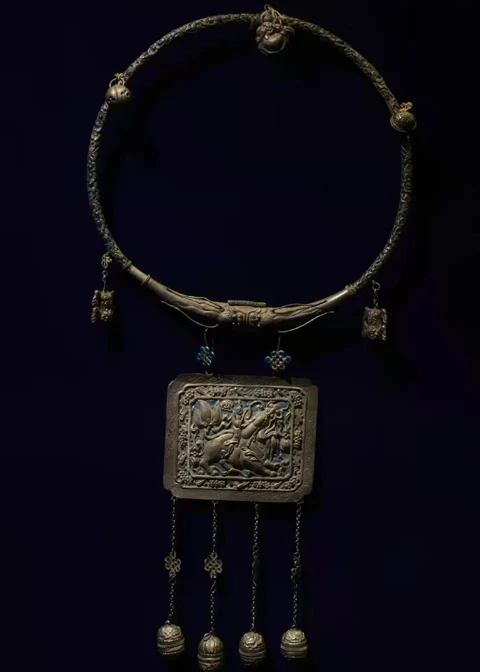
Qing Dynasty Chang Ming Suo
In the Qing Dynasty, the "Chao Zhu" worn by princes and nobles was also a characteristic traditional necklace. Derived on the basis of the Buddha beads, after the entry of Emperor Shunzhi of the Qing Dynasty, it was officially established as the standard wear of the court dress. It is an embodiment of prestige.
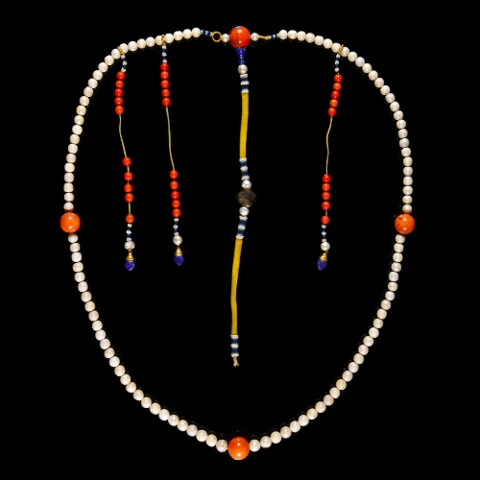
Qing Dynasty Dong Zhu Chao Zhu
Chao Zhu is made of precious material, with "Dong Zhu Chao Zhu (东珠朝珠)" being the rarest. According to the regulations at that time, only the Emperor, Empress Dowager and Empress could wear the Dong Zhu Chao Zhu.
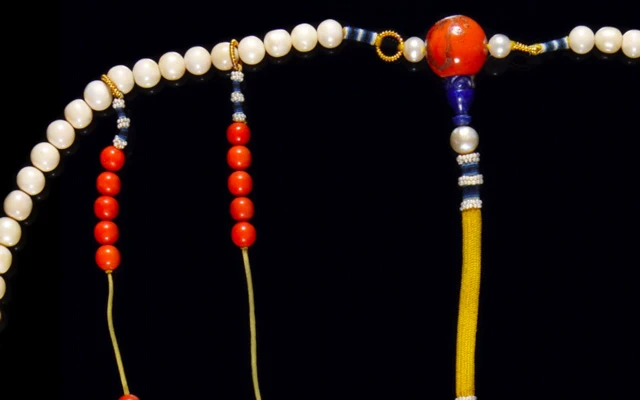
Qing Dynasty Dong Zhu Chao Zhu
From a small stone bead to a gorgeous gemstone necklace in a museum, the history of Chinese traditional necklace development has different characteristics in different times. These necklaces and choker are of different lengths, sizes, and styles, but they all contain a magnificent atmosphere, reflecting the ancient people's unchanging pursuit of beauty.
More about the history of traditional Chinese accessories.
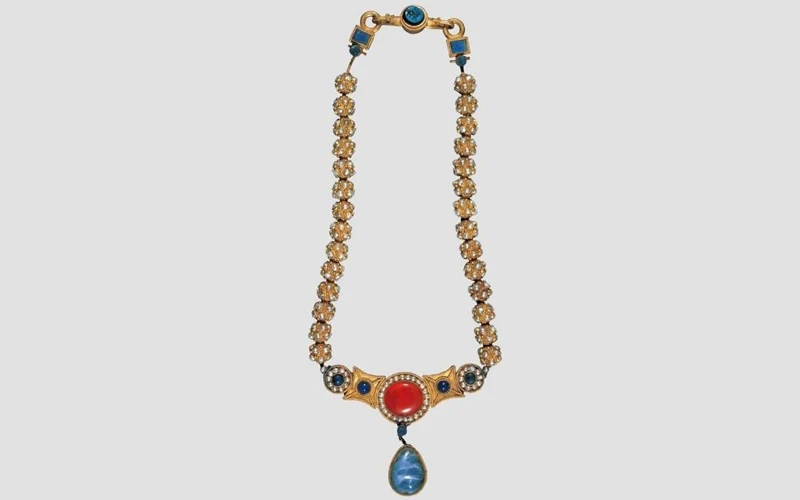


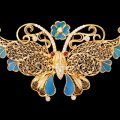
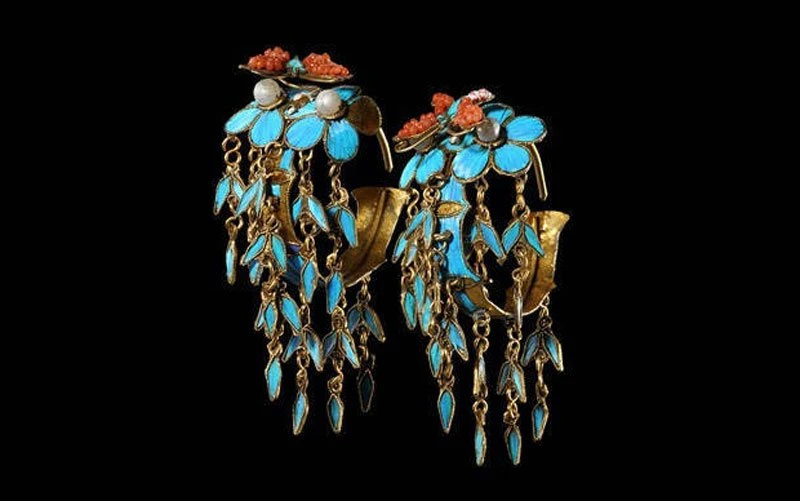
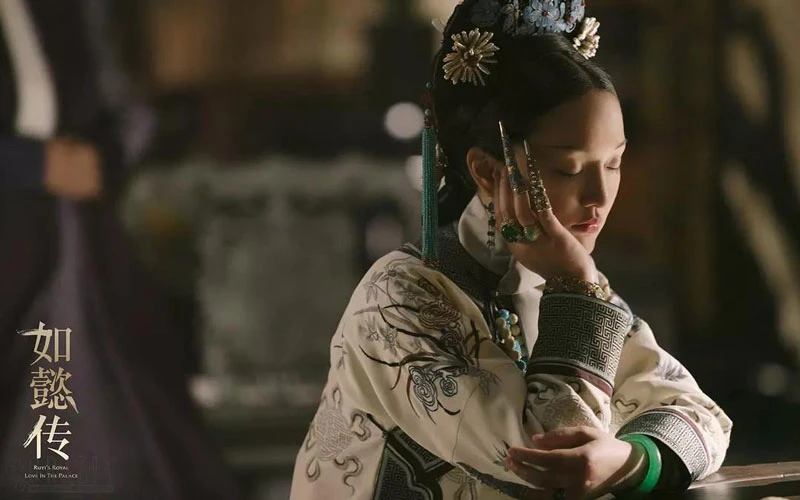

Pretty!
😍😍😍
Sungguh kreatif membuat perhiasan sendiri, cinta menjadi pusat keindahan
Pada dasarnya masnusia menyukai keindahan